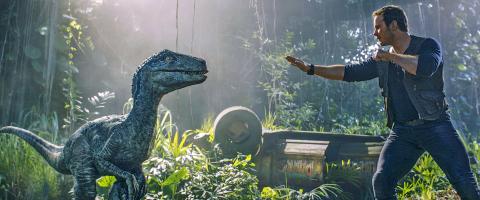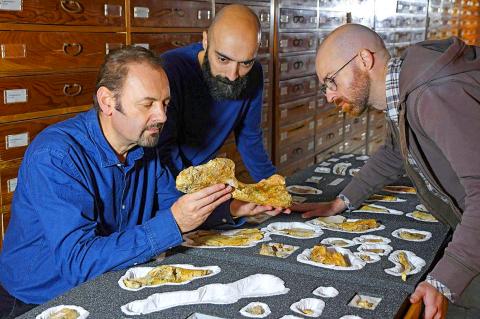Near crumbling cliffs outside Hastings in southern England, a herd of giant, plant-eating iguanodons gathered 130 million years ago and left their fossilized footprints embedded in the soil, Cambridge scientists revealed last week. Nearby, researchers also found the ancient tracks of a huge spike-covered dinosaur called an ankylosaurus. East Sussex was a busy place in Jurassic times, it seems.
In addition, Portsmouth University scientists last week outlined their discovery of a new species of flying reptile which once swooped above Britain. This giant raptor, Klobiodon rochei, had large fangs that would have meshed together to form a toothy cage, from which prey would have no escape once caught.
Nor have these newly discovered fossil wonders been confined to Britain.

Photo: AP
Scientists in South Africa recently announced they had found a new species of plant-eating dinosaur — Ledumahadi mafube — that was twice the size of an elephant while details of feathered dinosaurs, the predecessors of birds today, have been pouring out of China. Never has the probing of our prehistoric past been so productive.
It is a point stressed by Professor Paul Barrett of the Natural History Museum in London.
“It would be wrong to say we are about to enter a new golden age of paleontology. In fact, we have been in the middle of one for several years,” he said.

Photo: Reuters
This idea is backed by the fact there are now more paleontologists working the field than ever before; more countries are being exploited for their dinosaur remains; more new species are being dug up and named; and more interesting work — using new technologies — is being done on fossilized bones once they have been disinterred.
In the process, scientists are learning how animals and plants responded to the very different and frequently much warmer climates that prevailed in those days. In turn, this information could have key importance in understanding how our world might respond to global heating later this century, researchers say.
Nor is there any dispute about one of the most important factors that triggered this rebirth of dinosaur studies. It was the film Jurassic Park, which was released 25 years ago.
“Jurassic Park played a huge and under-appreciated role in the transformation of paleontology that we are now witnessing,” said Steve Brusatte, of Edinburgh University. “It used to be a rather dry academic topic carried out by old men at Oxbridge or Harvard. Today it is practiced by a diverse group of scientists in many parts of the world, and it was Jurassic Park that provided the momentum for that change.”
Paleontologist Susannah Maidment of the Natural History Museum agreed.
“I was a teenager when Jurassic Park came out, and although I was already interested in dinosaurs by that time, its massive popularity meant I was no longer embarrassed about talking about such a career. I didn’t feel like a nerd.”
At Bristol University, Mike Benton runs a masters course in paleontology.
“We have about 30 students a year, and we ask them what factor was the main influence in their decision to study dinosaurs. Jurassic Park gets the biggest show of hands.”
Other factors have played a role in the rebirth of dinosaur studies, however.
“National pride is certainly involved,” said Barrett. “Dinosaur fossils are now being found all over the world. China and South Africa have provided key sites in recent years, for example, and that has had important consequences.”
Paleontology is a cheap science that does not require huge telescopes or particle accelerators to proceed and can be used to kickstart scientific studies in a relatively poor nation.
“You don’t have to put a lot of money into the subject but you can still boost national prestige and develop scientific expertise,” said Barrett.
Paleontology has also benefited from technologies such as CAT scans, computer modeling and high-powered microscopes which reveal tiny fragments of pigment and indicate how colorful some dinosaurs could be.
Another example of this type of work was recently provided by Manchester University researchers who used computer simulations to show that the world’s most famous dinosaur, Tyrannosaurus rex, was not able to run at all and could only have lumbered towards its prey. Scavenging — not running after prey — was clearly a key part of its diet.
“It is this ability to give dinosaurs color and real lives that has also stimulated interest in them,” added Brusatte.
For good measure, there is the impact of dinosaur studies on the modern world. This has special relevance to research on the creatures and makes them important in resolving modern problems, said Maidment. One of the most important of these mysteries is known as the latitudinal biodiversity gradient.
“As you walk from the pole to the equator, you find the number of different species in a given area increases for each mile you travel towards the equator,” she said. “There are relatively few species at the poles and a lot at the equator. The trouble is that we don’t really know why species increase in that way because we have only one set of data — taken from the present day.
“If we can learn how things were in the past, when continents were in different positions or there was no ice at the poles, then we can gain an understanding of the phenomenon, and that will be crucial as global warming takes an effect on wildlife. How will diseases and their vectors behave and how will the growing of food be disrupted? Dinosaurs can teach us a lot.”
In the end, though, it is the simple sense of wonder that dinosaurs generate that has made them such a popular topic of investigation, said Benton. “Many of these creatures simply beggar belief. You have to ask: how the hell did that thing fly? How could something that vast even walk? You have to look at the physics of these creatures and realize they were doing something pretty wonderful.”

As we live longer, our risk of cognitive impairment is increasing. How can we delay the onset of symptoms? Do we have to give up every indulgence or can small changes make a difference? We asked neurologists for tips on how to keep our brains healthy for life. TAKE CARE OF YOUR HEALTH “All of the sensible things that apply to bodily health apply to brain health,” says Suzanne O’Sullivan, a consultant in neurology at the National Hospital for Neurology and Neurosurgery in London, and the author of The Age of Diagnosis. “When you’re 20, you can get away with absolute

When the South Vietnamese capital of Saigon fell to the North Vietnamese forces 50 years ago this week, it prompted a mass exodus of some 2 million people — hundreds of thousands fleeing perilously on small boats across open water to escape the communist regime. Many ultimately settled in Southern California’s Orange County in an area now known as “Little Saigon,” not far from Marine Corps Base Camp Pendleton, where the first refugees were airlifted upon reaching the US. The diaspora now also has significant populations in Virginia, Texas and Washington state, as well as in countries including France and Australia.

On April 17, Chinese Nationalist Party (KMT) Chairman Eric Chu (朱立倫) launched a bold campaign to revive and revitalize the KMT base by calling for an impromptu rally at the Taipei prosecutor’s offices to protest recent arrests of KMT recall campaigners over allegations of forgery and fraud involving signatures of dead voters. The protest had no time to apply for permits and was illegal, but that played into the sense of opposition grievance at alleged weaponization of the judiciary by the Democratic Progressive Party (DPP) to “annihilate” the opposition parties. Blamed for faltering recall campaigns and faced with a KMT chair

A police station in the historic sailors’ quarter of the Belgian port of Antwerp is surrounded by sex workers’ neon-lit red-light windows. The station in the Villa Tinto complex is a symbol of the push to make sex work safer in Belgium, which boasts some of Europe’s most liberal laws — although there are still widespread abuses and exploitation. Since December, Belgium’s sex workers can access legal protections and labor rights, such as paid leave, like any other profession. They welcome the changes. “I’m not a victim, I chose to work here and I like what I’m doing,” said Kiana, 32, as she